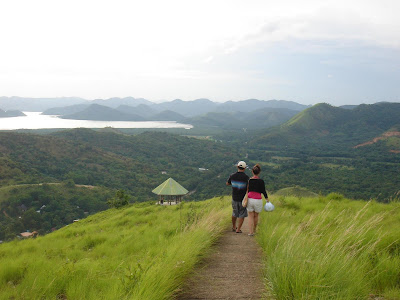Last August 8, my husband and I embarked on an 8AM 4D/3N journey to Coron, Palawan for our first wedding anniversary. It was our first out-of-town adventure as husband and wife.
Coron is one of the four municipalities – Coron, Busuanga, Culion and Linapacan – in the Calamianes group of islands in Northern Palawan. It is a relatively recent discovery in the list of tourist hot spots in the Philippines, but one that has fast gained popularity over the years with the variety of beautiful places it offers: from caves and lagoons to Japanese shipwrecks and white sand beaches that can rival that of Boracay’s.
Coron’s tribute to Hollywood, as seen from the port
Onboard next to us was a family who checked in humongous luggages as hand-carry. The things practically ate up all their leg space! Only in the Philippines! 🙂
The ride to Coron was a little bumpy. It was our first time to fly on a turboprop, so I’m not sure if this is a common occurrence but we felt at times that we hit “mini air pockets” halfway through to the end. But approaching a wealth of green terrains in Busuanga, excitement soon replaced the tension.
The flight from Manila to the Busuanga Airport took around 40 minutes, followed by a 30-minute land transfer to Coron town proper. Transportation is via aircon van, and is the only mode of transportation from the airport to Coron town proper. Ours was already included in the tour package we got with Coron Blue Lagoon Adventure Travel & Tours .
The land trip was refreshing, with trees and mountains abounding side by side. One gets a sort of primitive, back to basics feel passing by nothing but a vastness of greens. No buildings or towers, nothing commercial in sight (no cellphone signal too, especially for Sun, hehe), just a few thatched houses spaced several kilometers apart. Portions of the road are still unpaved, and creeks run under bridges that are supported by wooden planks.
We arrived at Darayonan Lodge well before lunchtime. This is said to be the lodge where GMA stayed during her Coron trip. The place had a homey feel in it. Rooms are spacious and pretty basic with A/C and hot running water. Walls are paper-thin; you could easily guess what TV show the room above yours is watching. Although, it’s one of the few lodges in the area that has a decent pool area and is very near the port (which is an advantage since the port is the jump-off point for virtually every island hopping tour).
Open lounge area with Wi-Fi access
The town lived a relatively quiet, uncomplicated way of life. Tricycles, being the main mode of transport in the area, can be found anywhere in the area. But unlike in the city, drivers here know how to give and take and always be on the right of way despite the absence of traffic enforcers and stoplights. People are generally warm, courteous and content with the simplicity of life ’round here. You wouldn’t see a single litter on the street (no, not even in the market). Obviously, the locals know that tourism is a burgeoning industry here and they take very good care not to ruin the business.
We were fetched by our tour guide, Ryan, at 3pm for the Coron town trip. Our first stop was a local souvenir shop and the town church.
The shop sells all kinds of products locally made in Coron, from ref magnets to chandeliers.
We got ourselves magnets for 20 pesos each, shirts at around P200-P300, native necklaces at P50.
We also dropped by the port area where most of the land has been recently reclaimed and where the soon-to-open posh Coron Gateway Hotel sits. We didn’t bother to look around the public market as our food’s already included in the package, but according to Ryan, fish and crustaceans are abundant here and you could buy a kilo of those for half the price in Manila markets. Pork and other meat products though are pretty scarce, which is why anything that’s mainly meat in Coron costs more than seafood.
Baywalk area with the majestic view of Coron Island
We headed next for a trek in Mt. Tapyas, which is a mere 10-minute tricycle ride from the port. The mountain is said to be around 700+ steps all the way up. The term Tapyas means chipped. During World War II bombing, part of the mountain has been chipped away, giving way to its monicker. We readied ourselves for the exciting albeit tiring hike.
As expected, the hike up was never easy even though the stairway was well-paved. By the 200th step, half of our water bottles have already been consumed and our breath was almost running out. Good thing they built shelters where one can take a rest every 200 steps or so.
View of Coron Island from halfway through the mountain
We encountered some brave souls along the way, like this native Tagbanuan kid who climbed the steep mountain without using the stairway. Way to go kid!
…And this rottweiler too who ran his way up faster than anybody could’ve walked it.
After 30 minutes, we were able to reach the top. The hike, no matter how tiring, was very rewarding. It offered us a 360 degree view of Coron and the surrounding islands. The view was nothing short of breathtaking, with the grassy mountains surrounding us, circled by a blue horizon of tiny isles and clear waters below.
 |
| On top of the hill is a huge cross that lights up in the evening |
There are two viewdecks on either side of the mountain where people can take a breather andenjoy the scenery. On the western part (although I can be mistaken as I am bad with NEWS), you can see Mt. Darala, a higher, dormant volcano just across Mt. Tapyas.
TIP: If you want to have a glimpse of the sunset overlooking the islands, it’s better to have a later hike (around 4 or 5 pm).
We descended our way down (a much, much easier walk, might I mention) and rode our way to Maquinit Hotspring. The road leading there is made of red earth, which according to Ryan is because of the abundant amount of manganese in the area.
Maquinit is the local term for hot, as temperatures in the spring can reach up to 45 degree Celsius. At that time, the temp was only about 37 degrees but man, did it feel scalding hot!
Maquinit is a good way to cap off the evening and relax aching muscles after a hike in the mountain. Water in the pool had an unusual salty taste (Tinikman talaga! haha). According to the locals, the algae in the pool walls contain the therapeutic organism Spirulina, too.
Entrance is at 100/person. Food and drinks may be brought inside.
Beside the pool is a mini mangrove forest embedded in the shallow waters of the sea
We had a picnic dinner of tinolang manok, buttered crabs and lato (seaweed) – all cooked by our tour operator’s sister-in-law – beside the pool. The food was incredibly tasty and fresh, especially the lato. Jigs isn’t fond of seaweed at all but my, did he devour a plateful!
Succulent lato
There were a few stray (but harmless) cats and dogs in the area, like this one who persistently tried to share my dinner 🙂
More and more tourists (as well as mosquitoes) flocked the place as night approached, so we took just one last short dip then decided to return back to the hotel. We couldn’t be more excited for the day ahead. It was just Day 1, and we’ve already visited a mountain and a spring, all in one island. Surely, there’s still a lot more to anticipate for and explore in this incredible town.
How to Get to Coron:
1) By Plane (from Manila)
There are daily flights to Coron being served by Air Philippines, Cebu Pacific, Seair, ZestAir (formerly known as Asian Spirit) and Philippine Airlines. Book a ticket to Busuanga then take an aircon van (150/head) at the Busuanga Airport bound for Coron town proper.
2) By Ferry (from Puerto Princesa)
If you are already in Puerto Princesa and would like to visit Coron, you may take the ferry via Superferry (Sunday trips only) or Negros Navigation (Saturday trips). Be prepared though for a 12-hour journey across the sea.
Getting around in Coron
Tricycles are always available anywhere for town tours (P300 for a whole day including Maquinit Hotspring and Mt. Tapyas). For island hopping tours, take a tricycle to the port (P8/head if you’re coming from Coron town) then board a boat to the destination of your choice. Tariff rates are pretty standard and are posted at the port area. Price range depends on the number of passengers, boat size, and destination. Boat rental for the Coron Island Tour costs P2000 for a group of 2-4. Make sure that the boat you’re renting has safety vests for everyone. You’ll be traveling in the open sea and no assurance can be given to you without these.
Alternatively, you may want to have arrangements made by a local travel agency for boat and land transportation. This is helpful for a group of two to three and ensures a sweat-free vacation. For bigger groups though, you may opt to join other groups and do a DIY trip to cut down costs. One popular DIY arranger is DIY Coron, owned by Owen Ferrer.



































we'll be visiting Coron this week (me and my bf).. Hoping we'll have an adventurous weekend as well.. Cheers! 😉